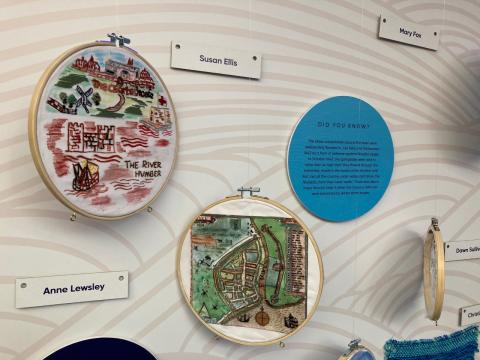In his second blog reviewing the climate resilience Showcase organised by the UK Climate Resilience Programme, Adam Walmesley, Senior Communications Executive for the Met Office, joins in with some creative workshops.
“Thanks for being brave enough to try something completely different,” said Dr Kate Smith from the Risky Cities team at the start of our Creative Reflections workshop during the UKCR Showcase event in Hull on 10-11 October 2022.
Our challenge was to create a visual response to climate change using embroidery. So we were given a needle and thread, paper and fabric, paint and brushes, and an embroidery hoop to frame our artwork.
Hull has a history of living with flooding since its founding in the 13th Century, causing significant impacts and loss of life. But research has suggested some local residents are unaware of the risk of flooding and how they could adapt.
Stitching together
The Risky Cities project is using the arts to represent people’s lived experiences of flooding in Hull to improve understanding and help communities become more flood resilient. The team have worked with local people to express their memories and responses to flooding through textiles and poetry.
The resulting artwork captures a variety of different responses to flooding. One focuses on numbers associated with the 2007 floods, when more than 10,000 homes were affected; another has a drawing of a car surrounded by water accompanied by the words ‘tidal wave’ while a third simply says, “Hull is a risky city”.
This approach is giving people the opportunity to develop their own sense of knowledge and expertise about climate risks and help them live better with floods. It has been described as inspirational – and even transformational. And it’s just way of responding creatively to climate change. (Find out more about Risky Cities’ community engagement work on this website.)
The power of poetry
The Risky Cities project mentions the work of metaphysical poet Andrew Marvell, who references flooding in Hull over 400 years ago in his famous poem, To His Coy Mistress. Returning to modern day poetry, Met Office Climate Scientist, Dr Erika Palin recently wrote two poems related to the UKCR Programme.
‘Reflections on a heatwave’ looks at the impacts of the record-breaking heatwave in July and why we need to take action. ‘Achieving a climate-resilient UK’ describes the UKCR Programme and how it is helping us to become climate resilient. Both poems were recited by Met Office weather presenter and climate communicator Alex Deakin.
Dramatic responses
Drama is another way of educating people about climate change and inspiring action. Professor Stephen Scott-Bottoms gave us a work-in-progress performance of ‘Who Ya Gunna Call? (in event of emergency)’ exploring the title question of his UKRI research project ‘Whose role is it to act on climate resilience?’
His play uses a combination of storytelling, facilitated discussion involving audience members and musical interludes to show that nobody can act alone on climate change, and to build resilience we need to work together.
The performance began with a monologue about the July heatwave, how it affected the whole country and individuals. It questioned who should have been responsible for preparing us. Then we explored the answer together through an adapted version of ‘Pass the parcel’ called ‘Whose job is it anyway?’ , with buckets of sand used to illustrate problems worsened by climate change, ranging from flooding, drought and wildfires to supply chain insecurity, and the burden on the healthcare system.
Emotional resilience
Stephen Scott-Bottoms’ play has since been performed to audiences (including local government employees) at the University of Leeds. It is provocative, at times political and yet empowering. Steve says: “We can all take action. Why not plant a few trees for better shade from the heat? Or some wildflowers for biodiversity? And let’s communicate better with our neighbours, so everyone has someone they can turn to locally when they’re feeling stressed or anxious.” He concludes that by acting together we can become more resilient.
A different performative approach was taken by the National Youth Theatre, again as part of the Risky Cities project, and the UKCR Showcase audience were shown a recording of their creative response, ‘On The Edge’, filmed at COP26 in Glasgow. The performance explores eco-anxiety and eco-anger in the face of climate uncertainty and shows how a group of young people from marginalised communities manage the challenges of flood risk, deprivation and unemployment, and develop ways of building resilience and adapting to climate change.
Climate change can often induce feelings of fear, sadness and despair at a reality that is both harder to ignore and tackle by ourselves. But the UKCR Showcase demonstrated that through art, poetry and drama people are being given some hope that by coming together we can find solutions to help us today and into the future.
Read Adam Walmesley’s other blog on the UKCR Showcase, Exploring place-based approaches to climate adaptation
Main image shows embroidered samplers from the Risky Cities project

